м•Ңкі лҰ¬мҰҳ м—°н•©мә н”„ м„ёлҜёлӮҳ 3-C (C++11 and ETC)
- 1. Seo youngsun(nein) Soongsil Univ.
- 2. в–Ә C++11 в–Ә Auto в–Ә Initializer Lists в–Ә Range-based for в–Ә Tuple в–Ә Lambda в–Ә STL в–Ә ETC
- 4. в–Ә Problem Solvingмқ„ н•ҳлҠ”лҚ° C++11лЎң н•ҙм•јн•ҳлҠ” мқҙмң в–Ә кё°мЎҙ C++мңјлЎңлҠ” н‘ңнҳ„н•ҳкё° м–ҙл Өмӣ лҚҳ мҪ”л“ңл“Өмқ„ 비көҗм Ғ к°„лӢЁн•ҳкІҢ м§Ө мҲҳ мһҲлӢӨ.(=л””лІ„к№…мқҙ мү¬мӣҢ진 лӢӨ.) в–Ә м„ұлҠҘмқҙ мЎ°кёҲмқҙм§Җл§Ң н–ҘмғҒлҗңлӢӨкі н•ңлӢӨ.
- 5. в–Ә AutoлҠ” м»ҙнҢҢмқј нғҖмһ„м—җ ліҖмҲҳ нғҖмһ…мқ„ мһҗлҸҷмңјлЎң м¶”лЎ н•ҳм—¬ м„ м–ён•ңлӢӨ.
- 6. в–Ә STL м»Ён…Ңмқҙл„ҲлӮҳ кө¬мЎ°мІҙ,нҒҙлһҳмҠӨмқҳ мҙҲкё°нҷ”лӮҳ min,max л“ұ лӢӨм–‘н•ҳкІҢ мӮ¬мҡ©лҗңлӢӨ.
- 8. в–Ә STLмқҳ м»Ён…Ңмқҙл„ҲлӮҳ л°°м—ҙ л“ұл“ұм—җм„ң лӘЁл“ мӣҗмҶҢлҘј мҲңнҡҢн•ҳлҠ” forл¬ё
- 9. в–Ә Stringмқҳ кІҪмҡ°лҠ” лӢӨмқҢ м•„лһҳлҘј мЈјмқҳн•ҙм•ј н•ңлӢӨ.
- 10. в–Ә Initializer ListsлҸ„ мӮ¬мҡ© к°ҖлҠҘн•ҳлӢӨ.
- 11. в–Ә Range-based forл¬ём—җм„ң м„ м–ён•ҳлҠ” ліҖмҲҳк°Җ л ҲнҚјлҹ°мҠӨ нғҖмһ…мқҙ м•„лӢҲл©ҙ, к°’ ліөмӮ¬к°Җ л°ңмғқн•ҳлҜҖ лЎң мЈјмқҳ
- 12. в–Ә TupleмқҖ pairмқҳ нҷ•мһҘнҳ•мңјлЎң 1~10к°ңмқҳ мӣҗмҶҢлҘј лӢҙмқ„ мҲҳ мһҲлӢӨ.
- 13. в–Ә мӣҗмҶҢлҠ” getмқ„ нҶөн•ҳм—¬ м ‘к·јн• мҲҳ мһҲлӢӨ.
- 14. в–Ә м•„мүҪкІҢлҸ„ м•„лһҳмҷҖ к°ҷмқҙлҠ” мӮ¬мҡ©мқҙ л¶Ҳк°ҖлҠҘн•ҳлӢӨ.
- 15. в–Ә TieлҠ” C++м—җм„ңлҠ” м§Җмӣҗмқ„ м•Ҳн•ҳлҠ” multi returnмқҙлӮҳ tuple, pairмқҳ мӣҗмҶҢлҘј н•ңлІҲм—җ ліөмӮ¬н• л•Ң мӮ¬мҡ©лҗңлӢӨ.
- 16. в–Ә Minmax н•ЁмҲҳм—җм„ң return лҗҳлҠ” к°’мқҙ pairмқҙкё° л•Ңл¬ём—җ лӢӨмқҢкіј к°ҷмқҙлҸ„ м“ё мҲҳ мһҲлӢӨ.
- 17. в–Ә LambdaлҠ” мқөлӘ… н•ЁмҲҳлЎң, кё°ліём Ғмқё нҳ•нғңлҠ” м•„лһҳмҷҖ к°ҷлӢӨ.
- 18. в–Ә C++м—җ мҲҳл§ҺмқҖ STLкіј н•ЁмҲҳл“Өмқҙ Lambdaн•ЁмҲҳлҘј м§Җмӣҗн•ңлӢӨ.
- 19. в–Ә л§Ңм•Ҫ л°”к№Ҙмқҳ мӣҗмҶҢлҘј м°ёмЎ°н•ҳм—¬ м •л ¬мқ„ н• кІҪмҡ°, лӢӨмқҢкіј к°ҷмқҙ н• мҲҳ мһҲлӢӨ.
- 20. в–Ә Lambdaн•ЁмҲҳмқҳ мһҗлЈҢнҳ•мқ„ м •мқҳн•ҳкі мӢ¶мңјл©ҙ, м•„лһҳмҷҖ к°ҷмқҙ м •мқҳн• мҲҳ мһҲлӢӨ. FuntionмқҖ functionalн—ӨлҚ” нҢҢмқј м•Ҳм—җ м •мқҳлҗҳм–ҙ мһҲлӢӨ.
- 21. в–Ә Lambdaн•ЁмҲҳмқҳ лҰ¬н„ҙнғҖмһ…мқ„ м§Җм •н•ҳл Ө н•ңлӢӨл©ҙ м•„лһҳмҷҖ к°ҷмқҙ н• мҲҳ мһҲлӢӨ.
- 23. в–Ә 2) м •м җ 분лҘҳ
- 24. в–Ә 3) DFS
- 25. в–Ә 4) all_of
- 26. в–Ә vectorлӮҳ queue, stack л“ұм—җм„ң мӣҗмҶҢлҘј л„Јмқ„ л•Ң emplaceлҘј мӮ¬мҡ©н•ҳл©ҙ constructorм—җ л§һм¶° м„ң мӣҗмҶҢк°Җ л“Өм–ҙк°„лӢӨ.
- 27. в–Ә C++11мқҙ лҗҳл©ҙм„ң 추к°Җлҗң STLмқҙ лӘҮк°Җм§Җ мһҲлӢӨ. в–Ә unordered_map в–Ә unordered_multimap в–Ә unordered_set в–Ә unordered_multiset в–Ә array
- 28. в–Ә HashлҘј мқҙмҡ©н•ҳм—¬ кө¬нҳ„лҗң mapмңјлЎң мқҙлЎ м ҒмңјлЎңлҠ” O(1)мқҳ мӢңк°„ліөмһЎлҸ„лҘј к°Җ진 dictionary мқҙлӢӨ. в–Ә HashлҘј мқҙмҡ©н•ҳкё° л•Ңл¬ём—җ мӣҗмҶҢк°Җ м •л ¬мқҙ лҗҳм–ҙмһҲм§ҖлҠ” м•ҠлӢӨ. в–Ә кё°мЎҙмқҳ std::mapкіј л§Өмҡ° мң мӮ¬н•ҳлҜҖлЎң кұ°мқҳ к·ёлҢҖлЎң мӮ¬мҡ©н•ҳл©ҙ лҗңлӢӨ. в–Ә лӢӨлҘё STLлҳҗн•ң нҒ° м°Ёмқҙк°Җ м—Ҷмңјл©°, multiк°Җ л¶ҷмқҖ кІғмқҖ мӣҗмҶҢлҘј мӨ‘ліөн•ҙм„ң к°Җм§Ҳ мҲҳ мһҲлӢӨ.
- 29. в–Ә VectorмҷҖ лӢ¬лҰ¬ нҒ¬кё°к°Җ кі м •лҗң м •м Ғ л°°м—ҙмқҙлӢӨ. в–Ә н•ҳм§Җл§Ң int[]мҷҖ к°ҷмқҖ л°°м—ҙкіј лӢ¬лҰ¬ STL м•Ңкі лҰ¬мҰҳ н•ЁмҲҳл“Өм—җ м Ғмҡ©мқҙ к°ҖлҠҘн•ҳл©°, к·ё мҷём—җлҸ„ лӢӨ м–‘н•ң кІғмқ„ м§Җмӣҗн•ңлӢӨ. в–Ә к·ёлҹ¬лӮҳ л©”лӘЁлҰ¬лҘј м—¬мң мһҲкІҢ мһЎм•„ мӮ¬мҡ©н•ҳлҠ” лҢҖнҡҢм—җм„ңлҠ” нҒ¬кІҢ нҷңмҡ©м„ұмқҖ м—ҶлҠ” л“Ҝ н•ҳлӢӨ;;
- 30. в–Ә C++11 л¶Җн„° м •к·ңн‘ңнҳ„мӢқмқ„ м§Җмӣҗн•ңлӢӨ. в–Ә мӮ¬мҡ©н•ҳкё°м—җ л”°лқјм„ң кҪӨ м“ё л§Ңн•ҳкІ м§Җл§Ң, мқјлӢЁ нҢЁмҠӨ
- 31. в–Ә C++11м—җ 추к°Җлҗң кІғмқҖ м•„лӢҲкі , кё°мЎҙм—җ мһҲлҠ” нҒҙлһҳмҠӨмқҙм§Җл§Ң к°„лӢЁн•ҳкІҢ лӮҳл§Ҳ лӢӨлӨ„ліјк№Ң н•ңлӢӨ. в–Ә Bitмқҳ кІҪмҡ° BitmaskлҘј нҶөн•ң лҸҷм Ғкі„нҡҚлІ• н•ҙкІ°мқ„ н•ҳлҠ” кІҪмҡ°к°Җ мһҲкё° л•Ңл¬ём—җ PSм—җм„ң мў…мў… мӮ¬ мҡ©лҗңлӢӨ. в–Ә лҢҖн‘ңм Ғмқё Bit м—°мӮ°мқ„ мҷёмӣҢм„ң мӮ¬мҡ©н•ҳм—¬лҸ„ кҙңм°®м§Җл§Ң, к·ёкІғмқҙ мӢ«лӢӨл©ҙ Bitsetмқ„ м°ҫм•„м„ң мӮ¬мҡ© н•ҙліҙлҠ” кІғлҸ„ н•ң л°©лІ•мқҙ лҗ кІғмқҙлӢӨ.
- 32. в–Ә м•„лһҳмҷҖ к°ҷмқҙ мӮ¬мҡ©мқҙ к°ҖлҠҘн•ҳл©°, []м—°мӮ°мһҗмҷҖ кё°мЎҙмқҳ bit м—°мӮ°мһҗлҘј м§Җмӣҗн•ңлӢӨ.
- 33. в–Ә лӢӨмқҢкіј к°ҷмқҖ кІғлҸ„ м§Җмӣҗн•ңлӢӨ.
- 34. в–Ә л§Һмқҙл“Ө лӢ№м—°мӢң лҗңлӢӨкі м°©к°Ғн•ҳлҠ” кұ°м§Җл§Ң C++11л¶Җн„° лҗҳлҠ” кІғмқҙлӢӨ. в–Ә classлӮҳ structм—җм„ң л§ҙлІ„ ліҖмҲҳлҘј м •мқҳн• л•Ң мҙҲкё°нҷ” н• мҲҳ мһҲлӢӨ.
- 35. в–Ә usingмқҙ C++11мңјлЎң мҳӨл©ҙм„ң typedefкіј кұ°мқҳ к°ҷмқҖ нҡЁкіјлҘј к°Җм§ҖкІҢ лҗҳм—ҲлӢӨ.
- 38. в–Ә л¬ём ңлҘј н’Җ л•Ң к°Ғ мғҒнҷ©лі„лЎң н•ҙкІ°н•ҙм•јн•ҳлҠ” мӮ¬мҶҢн•ң л¬ём ңл“Өмқҙ л§ҺлӢӨ. в–Ә мһ…л Ҙл¶Җн„° мӢңмһ‘н•ҳм—¬ лҚ°мқҙн„°лҠ” м–ҙл–»кІҢ м ҖмһҘн•ҙм•ј н•ҳлҠ”к°Җ л“ұ м•„мЈј м—¬лҹ¬к°Җм§Җ мғҒнҷ©м—җ м§Ғл©ҙн•ң лӢӨ. в–Ә мқҙлҹ¬н•ң л¬ём ңл“Өмқ„ н•ҙкІ°н• л•Ң к°Ғмһҗ л§Өмҡ° лӢӨм–‘н•ҳкі м°ёмӢ н•ң л°©лІ•л“ӨлЎң н•ҙкІ°н•ңлӢӨ. в–Ә мқҙлҹ¬н•ң л¬ём ңл“Өмқ„ к°Ғмһҗ н•ҙкІ°н•ҳкі кіөмң н•ҙліҙлҠ” мӢңк°„мқ„ к°Җм§Җмһҗ.
- 39. 1. л¶ҷм–ҙмһҲлҠ” мҲ«мһҗ л–Ём–ҙнҠёл Ө л°ӣкё° 2. EOF 3. char мһ…л Ҙ 4. л¬ёмһҗм—ҙ нҢҢмӢұн•ҙм„ң л°ӣкё°
- 46. в–Ә л§ҺмқҖ л¬ём ңл“Өмқҙ н•ңлІҲ мӢӨн–үм—җ м—¬лҹ¬ н…ҢмҠӨнҠё мјҖмқҙмҠӨлҘј нҶөкіјн•ҳм—¬м•ј н•ңлӢӨ. в–Ә л¬ём ңлҘј л§Һмқҙ н’ҖлӢӨліҙл©ҙ мқҙ л¶Җ분мқ„ мҪ”л”©н•ҳкё°к°Җ м җм җ к·Җм°®м•„м ё мҪ”л“ңк°Җ 짧아진лӢӨ.
- 47. int main(){ int tc; scanf(вҖң%dвҖқ,&tc); while(tc--){ //solve problem } }
- 48. в–Ә н…ҢмҠӨнҠё мјҖмқҙмҠӨмқҳ мҲҳлҘј мЈјлҠ” кІҪмҡ°лҸ„ мһҲм§Җл§Ң, мІҳмқҢ мһ…л Ҙмқҙ м „л¶Җ 0мқҙкұ°лӮҳ м•„мҳҲ м•„л¬ҙ мһ…л ҘлҸ„ м•ҲмЈјм–ҙм§ҖлҠ” кІҪмҡ° л“ұ лӢӨм–‘н•ң кІҪмҡ°к°Җ мһҲлӢӨ.
- 49. // 0 0 мқј л•Ң мў…лЈҢ int n,m; scanf(вҖң%d%dвҖқ,&n,&m); if(n+m==0)break; // EOFмқјл•Ң мў…лЈҢ if(scanf(вҖң%d%dвҖқ,&n,&m)==EOF)break;
- 50. в–Ә for loopлҘј лҸҢл Ө мҙҲкё°нҷ”лҘј н•ҙмЈјлҠ” кІҪмҡ°лҸ„ мһҲм§Җл§Ң, memsetн•ЁмҲҳлҘј мқҙмҡ©н•ҳм—¬ м „мІҙлҘј мҙҲкё° нҷ”лҘј н•ҳлҠ”кІҪмҡ°к°Җ л§ҺлӢӨ. в–Ә к°„нҳ№ лӘЁл“ н…ҢмҠӨнҠё мјҖмқҙмҠӨм—җ лҢҖн•ҙм„ң м „мІҙлҘј мҙҲкё°нҷ”н•ҳм—¬ мӢңк°„мҙҲкіјк°Җ лӮҳлҠ” кІҪмҡ°к°Җ мһҲм§Җл§Ң, л“ңл¬ё кІҪмҡ°лқј л§Һмқҙл“Ө мӮ¬мҡ©н•ңлӢӨ.
- 51. в–Ә memset(мҙҲкё°нҷ” мӢңмһ‘н• мЈјмҶҢ,мҙҲкё°нҷ” н• к°’(1л°”мқҙнҠё),мҙҲкё°нҷ”н• л°”мқҙнҠё мҲҳ) в–Ә int dy[50][50]; в–Ә memset(dy,0x3f,sizeof(dy) в–Ә 0x7f : 0x7f7f7f7f memsetмңјлЎң мҙҲкё°нҷ” н• мҲҳ мһҲлҠ” мөңлҢҖ int нҒ¬кё° в–Ә 0x3f : 0x3f3f3f3f мҳӨлІ„ н”ҢлЎңмҡ° л°©м§ҖлҘј мң„н•ң м ҒлӢ№н•ң int нҒ¬кё° в–Ә 0 : 0мңјлЎң мҙҲкё°нҷ” в–Ә 0xff : -1лЎң мҙҲкё°нҷ”, л©”лӘЁмқҙм ңмқҙм…ҳм—җм„ң л§Һмқҙ мӮ¬мҡ© в–Ә 0x80 : 0x80808080 memsetмңјлЎң мҙҲкё°нҷ” н• мҲҳ мһҲлҠ” мөңмҶҢ intнҒ¬кё°
- 52. в–Ә л¬ём ңлҘј н’ҖлӢӨ ліҙл©ҙ лӢӨм–‘н•ң мғҒмҲҳ к°’мқ„ мҪ”л“ңм—җ л„ЈлҠ”лӢӨ. в–Ә const int MOD=1000000007; в–Ә double PI=acos(-1); в–Ә const int INF=0x7fffffff; в–Ә const int INF=0x7fffffff/2; // overflow л°©м§Җ в–Ә const int MIN=0x80000000;
- 53. в–Ә к°„нҳ№ мһ…л ҘмңјлЎң мЈјм–ҙ진 мҲҳм—ҙмқҳ мӣҗмҶҢл“Өмқҳ мӨ‘ліөмқ„ м ңкұ°н•ҳкі лӘҮлІҲм§ё мӣҗмҶҢмқём§Җ кө¬н•ҙм•ј н•ҳлҠ” кІҪмҡ°к°Җ мһҲлӢӨ. в–Ә https://www.acmicpc.net/problem/10867 в–Ә мўҢн‘ң 압축
- 54. set or map мӮ¬мҡ© vector<int> arr ={1,3,6,3,2,3,1}; vector<int> X=arr; std::sort(X.begin(),X.end()); X.erase(std::unique(X.begin(),X.end()),X.end()); for(int num:arr){ int idx=std::lower_bound(X.begin(),X.end(),num)-X.begin(); }
- 55. в–Ә к°„м„ мқҳ м •ліҙк°Җ мЈјм–ҙмЎҢмқ„ л•Ң, лӘЁл“ м •м җмқ„ н•ңлІҲм”© л°©л¬ё в–Ә n*n кІ©мһҗнҢҗм—җм„ң мөңлӢЁкұ°лҰ¬ м°ҫкё° в–Ә https://www.acmicpc.net/problem/7576
- 56. в–Ә c++ 11л¬ёлІ•мқҳ typedefкіј к°ҷмқҖ м—ӯн• мҷём—җлҸ„ л§ҺмқҖ мқјмқ„ н•ңлӢӨ. в–Ә л§ҺмқҖ мӮ¬лһҢл“Өмқҙ using namespace std;лҘј мӮ¬мҡ©н•ҳлҠ”лҚ° мқҙлҠ” м „м—ӯліҖмҲҳлҘј м„ м–ён• л•Ң, std namespaceм•Ҳм—җ мһҲлҠ” л¬ҙм–ёк°ҖмҷҖ кІ№м№ҳлҠ” кІҪмҡ° м»ҙнҢҢмқј м—җлҹ¬к°Җ лӮңлӢӨ. в–Ә using std::vector; мҷҖ к°ҷмқҖ л°©лІ•мқ„ мӮ¬мҡ©н•ҳл©ҙ н•„мҡ”н•ң кІғл§Ң к°Җм ёмҷҖ лӘ…мӢңм ҒмңјлЎң н‘ңнҳ„н•ҳкё°м—җ мқҙм—җ лҢҖн•ң м—җлҹ¬лҘј лҢҖл№„н• мҲҳ мһҲлӢӨ.
- 57. в–Ә л¬ём ң мӨ‘ string мқ„ мҲ«мһҗлЎң л°”кҝ”м„ң н’Җм–ҙм•ј н•ҳлҠ” кІҪмҡ°к°Җ мһҲлӢӨ. в–Ә https://www.acmicpc.net/problem/13168
- 58. std::map<std::string,int> map; int num(std::string& str){ if(!map.count(str))map[str]=map.size(); return map[str]; }
- 59. в–Ә м ҲлҢҖк°’ н•ЁмҲҳ absлҠ” нҠ№м • лқјмқҙлёҢлҹ¬лҰ¬л§Ң includeн•ҳл©ҙ мӢӨмҲҳ мһҗлЈҢнҳ•м—җ лҢҖн•ҙм„ңл§Ң м„ м–ёлҗңлӢӨ. в–Ә к·ёлғҘ л§Ңл“Өм–ҙ м“°лҠ”кІҢ л§ҲмқҢ нҺён•ҳлӢӨ.
- 60. в–Ә maximum flowл¬ём ңл“Өмқ„ н’ҖлӢӨліҙл©ҙ м •м җл“Өм—җкІҢ лІҲнҳёлҘј мһҳ л§ӨкІЁм•ј н•ҳлҠ” кІҪмҡ°к°Җ мһҲлӢӨ. в–Ә ліҙнҶө мҲҳмӢқмқ„ л§Ңл“Өм–ҙ м§Ғм ‘ л•Ңл Ө л„ЈлҠ”лҚ°, мӨ‘к°„м—җ мҳӨнғҖлқјлҸ„ лӮҳл©ҙмқҖ л°”лЎң н—¬кІҢмқҙнҠёк°Җ м—ҙлҰ°лӢӨ.
- 61. int source=0; int sink=n+m+1; auto L=[&](int i){return i+1;}; auto R=[&](int i){return i+n+1;}; s 0 1 n-1 0 1 m-1 t
- 62. в–Ә fabs(double) // мӢӨмҲҳ м ҲлҢҖк°’ в–Ә sqrt(double) // м ңкіұк·ј в–Ә hypot(double,double) // sqrt(a*a+b*b) , мң нҒҙлҰ¬л“ң кұ°лҰ¬
- 64. в–Ә нҸүмҶҢ мҪ”л”©мқ„ н•ҳл©ҙм„ң к°„лӢЁн•ҳкІҢ мӮ¬мҡ©н•ҳкі мһҲлӢӨлҠ” кІғмқ„ лӘЁм•„лҙӨлӢӨ. в–Ә к°ңмқём ҒмңјлЎң кҙңм°®лӢӨкі мғқк°Ғн•ҳлҠ” кІғмқҙлӢҲ лі„лЎңлқјкі мғқк°Ғн•ҳл©ҙ м•ҲмҚЁлҸ„ кҙңм°®лӢӨ.
- 65. в–Ә л§Ё лҒқм—җ NULLл¬ёмһҗк°Җ мһҲмқҢмқ„ мқҙмҡ©н•ҙ loopмқҳ лҒқмқ„ м§Җм •
- 66. в–Ә нҠ№м • format(e.g., time,кіөл°ұм—ҶлҠ” мҲ«мһҗ)мқҳ мһ…л Ҙкіј м¶ңл Ҙм—җ лҢҖн•ҙм„ңлҠ” scanfмҷҖ printfлҘј мһҳ мӮ¬мҡ©н•ҳл©ҙ нҺён•ҙ진лӢӨ.
- 67. в–Ә лӮҙл¶Җмқҳ мһҲлҠ”м§Җ нҢҗлӢЁн•ҳлҠ” кІғм—җ лҢҖн•ҙм„ң л”° лЎң н•ЁмҲҳлҘј л§Ңл“Өм–ҙ мӮ¬мҡ©н•ҳл©ҙ мҪ”л“ңк°Җ к№”лҒ” н•ҙ진лӢӨ. в–Ә лҳҗн•ң 4л°©н–ҘмңјлЎң мқҙлҸҷн•ҳлҠ” кІғм—җм„ң лӢӨмқҢ кіј к°ҷмқҙ н•ҳл©ҙ ліөл¶ҷмӢ кіөмқ„ л°ңнңҳн•ҳм§Җ м•Ҡм•„ лҸ„ мҪ”л”©мқ„ н• мҲҳ мһҲлӢӨ.
- 68. в–Ә лӮҙл¶ҖлЎң лӮҳк°ҖлҠ” кІғм—җ лҢҖн•ң мІҳлҰ¬лҘј л”°лЎң мІҳ лҰ¬ н•ҳкё° мӢ«лӢӨл©ҙ л°°м—ҙ нҒ¬кё°лҘј кІүмңјлЎң н•ң м№ём”© лҚ” мһЎм•„ лІҪмңјлЎң мҙҲкё°нҷ” н•ҙл‘җлҠ” л°©лІ• лҸ„ мһҲлӢӨ.
- 69. в–Ә мў…мў… м•„мҠӨнӮӨ мҪ”л“ң к°’мқ„ мҷёмӣҢм„ң н•ҳмӢңлҠ” 분 л“Өмқҙ мһҲлҠ”лҚ° мһ‘мқҖл”°мҳҙн‘ңм•Ҳм—җ л¬ёмһҗлҘј л„Ј мңјл©ҙ мһҗлҸҷмңјлЎң м•„мҠӨнӮӨ мҪ”л“ңлЎң ліҖнҷҳлҗңлӢӨ.
- 70. в–Ә м •мҲҳк°’м—җм„ң мһҗлҰ¬л§ҲлӢӨ мІҳлҰ¬лҘј н• л•Ңм—җлҠ” лӮҳлҲ„кё°мҷҖ лӮҳлЁём§ҖлҘј м ҒлӢ№нһҲ мӮ¬мҡ©н•ңлӢӨ,
- 71. в–Ә лӮҳлЁём§Җм—°мӮ°мқҖ л•Ңм—җ л”°лқјм„ң к·Җм°®мқҖ мҪ”л“ңлҘј к°„лӢЁн•ҳкІҢ л§Ңл“Өм–ҙмӨҖлӢӨ.(e.g. ACM Hotel) в–Ә ліҙнҶө лӮҳлЁём§Җ м—°мӮ°мқ„ н•ҳл©ҙ 0~n-1к°’мқҙ лӮҳмҳӨм§Җл§Ң л•Ңм—җ л”°лқјм„ң 1~nк°’мқҙ н•„мҡ” н• л•Ңк°Җ мһҲлӢӨ. в–Ә лӢӨмқҢкіј к°ҷмқҖ мғҒнҷ©м—җм„ңлҠ” мҳҶкіј к°ҷмқҙ н•ҳл©ҙ лҗңлӢӨ.
- 72. в–Ә мқјл°ҳм ҒмңјлЎң м •мҲҳк°’ лӮҳлҲ„кё°лҠ” лӮҙлҰјмңј лЎң кі„мӮ° лҗҳм§Җл§Ң л•Ңм—җ л”°лқј мҳ¬лҰј, л°ҳмҳ¬ лҰјмқҙ н•„мҡ”н• мҲҳ мһҲлӢӨ. в–Ә лӢӨмқҢкіј к°ҷмқҖ л°©лІ•мңјлЎң мҳ¬лҰј, л°ҳмҳ¬лҰјмқ„ кө¬нҳ„н• мҲҳ мһҲл”°.
- 73. в–Ә мӢңк°„кіј к°ҷмқҙ лӢЁмң„к°Җ м—¬лҹ¬ к°ңк°Җ мһ…л ҘмңјлЎң л“Өм–ҙмҳӨлҠ” кІҪмҡ°к°Җ мһҲлӢӨ. в–Ә к·ёлҹ¬н•ң л¬ём ңлҠ” мөңмҶҢ лӢЁмң„лЎң ліҖнҷҳн•ң нӣ„ н’Җл©ҙ нҺён•ҳлӢӨ.
- 74. в–Ә мһ‘л…„ мқён„°л„· мҳҲм„ м—җ нҠ№м • B진법мңјлЎң ліҖнҷҳн•ҳлҠ” л¬ём ңк°Җ мһҲлҠ”лҚ° мқҙлҹ° л¬ём ңлҘј лҢҖ비н•ҙм„ң 진 лІ• ліҖнҷҳмқ„ мқјл°ҳнҷ” н•ҙлҶ“мқҖ кІғмқ„ м•Ңм•„л‘җл©ҙ нҺён•ҳлӢӨ. в–Ә к°Ғ мһҗлҰҝмҲҳлҠ” B^nмқҳ лӮҳлЁём§Җ к°’л“Өмқҙкё° л•Ңл¬ём—җ лӢӨмқҢкіј к°ҷмқҙ м§ңл©ҙ лҗңлӢӨ.
- 75. в–Ә мһҗмЈј мӮ¬мҡ©лҗҳлҠ” мғҒмҲҳ(лӮҳлЁём§Җ к°’) мқҳ кІҪмҡ°, мҳӨнғҖлЎң мқён•ң мҳӨлӢөмқ„ л°© м§Җн•ҳкё° мң„н•ҙм„ң л”°лЎң м„ м–ён•ҙм„ң м“° лҠ” кІғмқҙ мўӢлӢӨ. в–Ә лҳҗн•ң, м—¬лҹ¬ к°ңк°Җ мһҲлҠ” кІҪмҡ° л°°м—ҙ лЎң 묶м–ҙм„ң мІҳлҰ¬н•ҙмЈјл©ҙ мўӢлӢӨ.
- 76. в–Ә л¬ём ңм—җ л”°лқј м •лӢөмқҙ м—Ҷмқ„ л•Ң -1мҷҖ к°ҷмқҖ нҠ№м • к°’мқ„ м¶ңл Ҙн•ҳкі н• л•Ңк°Җ мһҲлӢӨ. в–Ә мқҙлҹ¬н•ң кІҪмҡ° мӣҗлһҳ м •лӢөмқҙ лӢҙкІЁмһҲлҠ” кіім—җ к·ё к°’мқ„ л„ЈлҠ” л°©лІ•мқ„ мҚЁлҸ„ кҙңм°®лӢӨ.
- 77. в–Ә н”јліҙлӮҳм№ҳмҷҖ к°ҷмқҖ к°„лӢЁн•ң м җнҷ”мӢқмқҳ кІҪмҡ° лӢӨмқҢкіј к°ҷмқҙ к°„лӢЁн•ҳкІҢ мҙҲкё°нҷ”лҘј н• мҲҳ мһҲлӢӨ.
- 78. в–Ә л¬ёмһҗм—ҙ мІҳлҰ¬мқҳ кІҪмҡ° char[]ліҙлӢӨ std::stringмқҙ нҷ•мӢӨнһҲ нҡЁкіјм Ғмқј л•Ңк°Җ л§ҺлӢӨ. в–Ә н•ҳм§Җл§Ң, мһ…м¶ңл Ҙ мҶҚлҸ„ л¬ём ңлЎң std::cin,std::coutмқҖ кәјл Өн•ҳкё°к°Җ ліҙнҶөмқёлҚ°, scanfлӮҳ printfм—җ м„ңлҠ” лӢӨмқҢкіј к°ҷмқҖ л°©лІ•мңјлЎң м“ё мҲҳ мһҲлӢӨ.
- 79. в–Ә C++ reference - http://www.cplusplus.com/ в–Ә C++11 вҖ“ choi backjoon, startlink https://www.acmicpc.net/blog/view/10 в–Ә н”„лЎңк·ёлһҳл°Қ лҢҖнҡҢ : C++11 мқҙм•јкё° вҖ“ choi Jongwook http://www.slideshare.net/JongwookChoi/c11-draft?qid=9b8d3626-73a4-4d09- a5e5-4f5afaefb2f9&v=&b=&from_search=2




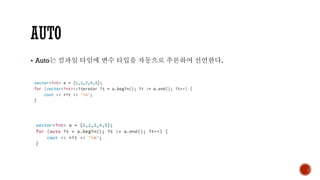


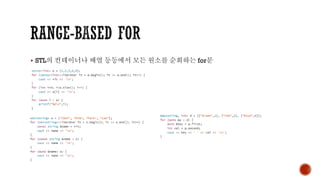
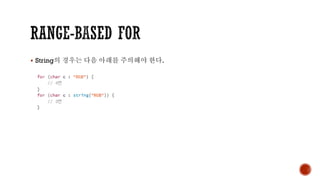
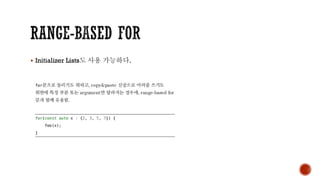
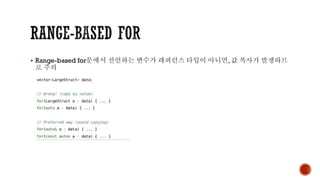
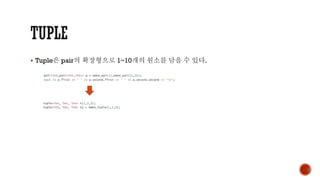

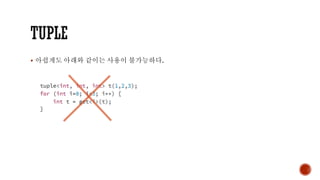
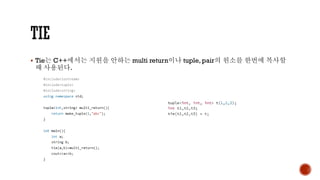
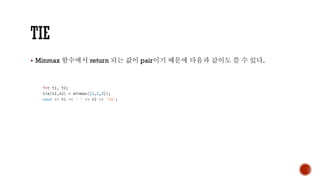
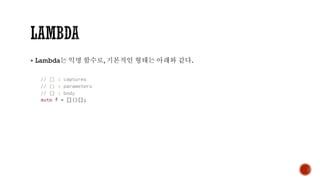
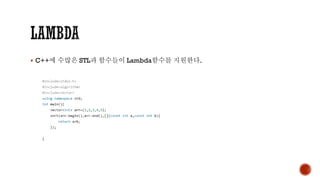

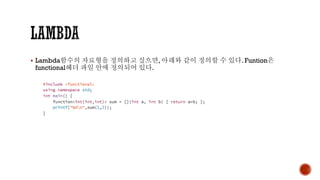

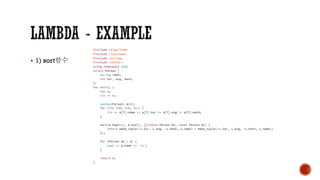




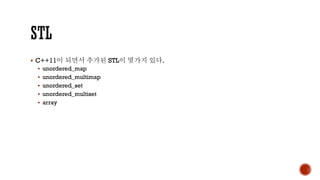

![в–Ә VectorмҷҖ лӢ¬лҰ¬ нҒ¬кё°к°Җ кі м •лҗң м •м Ғ л°°м—ҙмқҙлӢӨ.
в–Ә н•ҳм§Җл§Ң int[]мҷҖ к°ҷмқҖ л°°м—ҙкіј лӢ¬лҰ¬ STL м•Ңкі лҰ¬мҰҳ н•ЁмҲҳл“Өм—җ м Ғмҡ©мқҙ к°ҖлҠҘн•ҳл©°, к·ё мҷём—җлҸ„ лӢӨ
м–‘н•ң кІғмқ„ м§Җмӣҗн•ңлӢӨ.
в–Ә к·ёлҹ¬лӮҳ л©”лӘЁлҰ¬лҘј м—¬мң мһҲкІҢ мһЎм•„ мӮ¬мҡ©н•ҳлҠ” лҢҖнҡҢм—җм„ңлҠ” нҒ¬кІҢ нҷңмҡ©м„ұмқҖ м—ҶлҠ” л“Ҝ н•ҳлӢӨ;;](https://image.slidesharecdn.com/3-cc11andetc-170828020810/85/3-C-C-11-and-ETC-29-320.jpg)


![в–Ә м•„лһҳмҷҖ к°ҷмқҙ мӮ¬мҡ©мқҙ к°ҖлҠҘн•ҳл©°, []м—°мӮ°мһҗмҷҖ кё°мЎҙмқҳ bit м—°мӮ°мһҗлҘј м§Җмӣҗн•ңлӢӨ.](https://image.slidesharecdn.com/3-cc11andetc-170828020810/85/3-C-C-11-and-ETC-32-320.jpg)
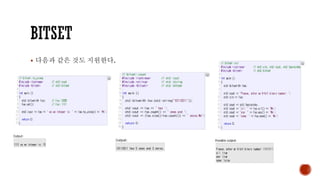
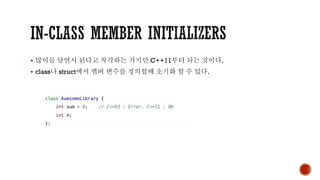
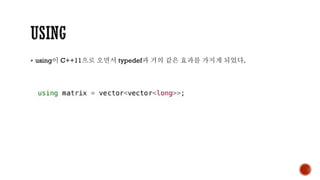
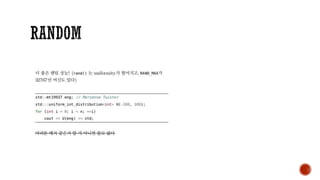




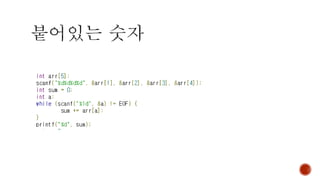



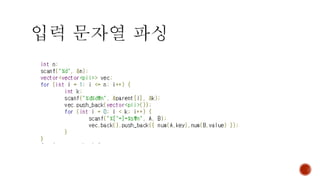

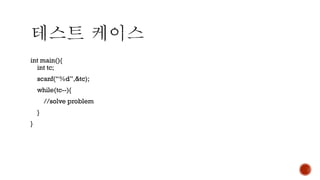


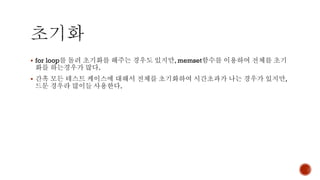
![в–Ә memset(мҙҲкё°нҷ” мӢңмһ‘н• мЈјмҶҢ,мҙҲкё°нҷ” н• к°’(1л°”мқҙнҠё),мҙҲкё°нҷ”н• л°”мқҙнҠё мҲҳ)
в–Ә int dy[50][50];
в–Ә memset(dy,0x3f,sizeof(dy)
в–Ә 0x7f : 0x7f7f7f7f memsetмңјлЎң мҙҲкё°нҷ” н• мҲҳ мһҲлҠ” мөңлҢҖ int нҒ¬кё°
в–Ә 0x3f : 0x3f3f3f3f мҳӨлІ„ н”ҢлЎңмҡ° л°©м§ҖлҘј мң„н•ң м ҒлӢ№н•ң int нҒ¬кё°
в–Ә 0 : 0мңјлЎң мҙҲкё°нҷ”
в–Ә 0xff : -1лЎң мҙҲкё°нҷ”, л©”лӘЁмқҙм ңмқҙм…ҳм—җм„ң л§Һмқҙ мӮ¬мҡ©
в–Ә 0x80 : 0x80808080 memsetмңјлЎң мҙҲкё°нҷ” н• мҲҳ мһҲлҠ” мөңмҶҢ intнҒ¬кё°](https://image.slidesharecdn.com/3-cc11andetc-170828020810/85/3-C-C-11-and-ETC-51-320.jpg)
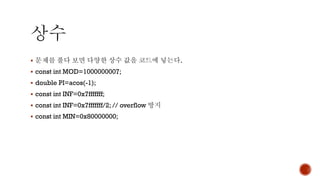





![std::map<std::string,int> map;
int num(std::string& str){
if(!map.count(str))map[str]=map.size();
return map[str];
}](https://image.slidesharecdn.com/3-cc11andetc-170828020810/85/3-C-C-11-and-ETC-58-320.jpg)


{return i+1;};
auto R=[&](int i){return i+n+1;};
s
0
1
n-1
0
1
m-1
t](https://image.slidesharecdn.com/3-cc11andetc-170828020810/85/3-C-C-11-and-ETC-61-320.jpg)
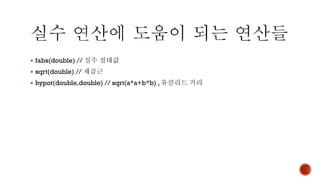
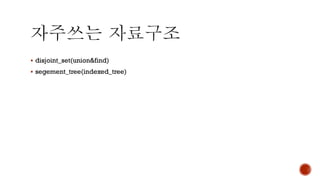

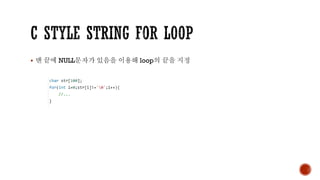


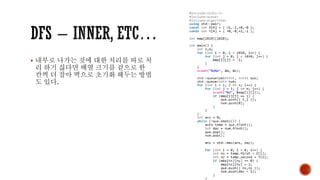
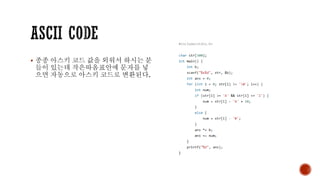
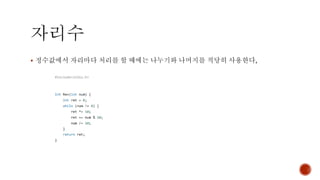
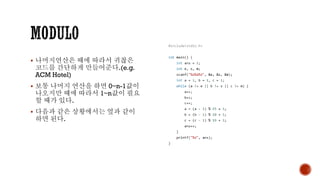




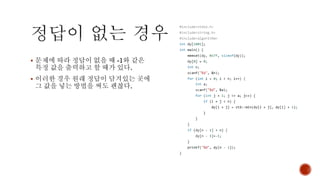

![в–Ә л¬ёмһҗм—ҙ мІҳлҰ¬мқҳ кІҪмҡ° char[]ліҙлӢӨ std::stringмқҙ нҷ•мӢӨнһҲ нҡЁкіјм Ғмқј л•Ңк°Җ л§ҺлӢӨ.
в–Ә н•ҳм§Җл§Ң, мһ…м¶ңл Ҙ мҶҚлҸ„ л¬ём ңлЎң std::cin,std::coutмқҖ кәјл Өн•ҳкё°к°Җ ліҙнҶөмқёлҚ°, scanfлӮҳ printfм—җ
м„ңлҠ” лӢӨмқҢкіј к°ҷмқҖ л°©лІ•мңјлЎң м“ё мҲҳ мһҲлӢӨ.](https://image.slidesharecdn.com/3-cc11andetc-170828020810/85/3-C-C-11-and-ETC-78-320.jpg)
